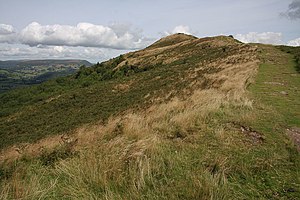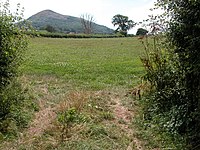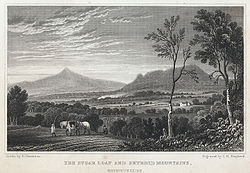Difference between revisions of "Skirrid"
m |
|||
| (One intermediate revision by one other user not shown) | |||
| Line 8: | Line 8: | ||
|height=1,594 feet | |height=1,594 feet | ||
|os grid ref=SO331182 | |os grid ref=SO331182 | ||
| + | |latitude=51.858358 | ||
| + | |longitude=-2.972825 | ||
}} | }} | ||
'''The Skirrid''' or '''Skirrid Fawr''' is a mountain of 1,594 feet in [[Monmouthshire]] which is an easterly outlier of the [[Black Mountains]]. It also forms the easternmost part of the [[Brecon Beacons]] National Park. | '''The Skirrid''' or '''Skirrid Fawr''' is a mountain of 1,594 feet in [[Monmouthshire]] which is an easterly outlier of the [[Black Mountains]]. It also forms the easternmost part of the [[Brecon Beacons]] National Park. | ||
| − | The mountain's name in Welsh is '''Ysgyryd Fawr'', meaning "Great Shattered Hill". Names also heard include ''Holy Mountain'' or ''Sacred Hill''. The spelling ''Skyrrid'' is encountered in older literature. [[Little Skirrid]], or ''Ysgyryd Fach'', is a hill of 886 feet found about | + | The mountain's name in Welsh is '''Ysgyryd Fawr'', meaning "Great Shattered Hill". Names also heard include ''Holy Mountain'' or ''Sacred Hill''. The spelling ''Skyrrid'' is encountered in older literature. [[Little Skirrid]], or ''Ysgyryd Fach'', is a hill of 886 feet found about three miles to the south. |
| − | The hill stands just outside [[Abergavenny]] in [[Monmouthshire]], about 10 miles from the [[Herefordshire]] | + | The hill stands just outside [[Abergavenny]] in [[Monmouthshire]], about 10 miles from the [[Herefordshire]] border. The [[Beacons Way]] passes along the ridge .<ref>{{cite web |url=http://www.breconbeacons.org/BeaconsWay/view?searchterm=Ysgyryd |publisher=Brecon Beacons National Park Authority |title=Beacons Way}}</ref> |
==Geology== | ==Geology== | ||
| − | The distinctive shape of this Old Red Sandstone hill comprises a long ridge oriented nearly north–south, with a jagged western side resulting from ice age landslips | + | The distinctive shape of this Old Red Sandstone hill comprises a long ridge oriented nearly north–south, with a jagged western side resulting from ice age landslips. The upper slopes of the hill are composed of Devonian age sandstones assigned to the Senni Formation (formerly known as the 'Senni Beds'). These overlie weaker mudstones of the St Maughans Formation - a situation which has contributed to the instability of the hill's steep flanks.<ref>British Geological Survey: memoir to Abergavenny geological map sheet 232</ref> |
[[File:Ysgyryd Fawr Geograph.jpg|left|thumb|200px|The Skirrid from the North]] | [[File:Ysgyryd Fawr Geograph.jpg|left|thumb|200px|The Skirrid from the North]] | ||
| + | |||
==Cultural associations== | ==Cultural associations== | ||
''Ysgyryd'' is a word describing the hill's shape, signifying that which has shivered or been shattered [http://www.geograph.org.uk/photo/338572]. There is a rich mythology attached to the mountain.<ref>{{cite web |url=http://www.themodernantiquarian.com/post/35394 |publisher=The Modern Antiquarian |title=Ysgyryd Fawr |author=Rhiannon |date=8 March 2005}}</ref> A distinctive stone on the hill is known as 'the Devil's Table', and according to legend, part of the mountain is said to have been broken off at the moment of the crucifixion of Jesus. There was a local tradition that earth from the Skirrid was holy and especially fertile, and it was taken away to be scattered on fields elsewhere, on coffins, and in the foundations of churches.<ref>Roy Palmer, ''The Folklore of (old) Monmouthshire'', 1998, ISBN 1-873827-40-7</ref> Pilgrimages were made, especially on Michaelmas Eve, to the summit. | ''Ysgyryd'' is a word describing the hill's shape, signifying that which has shivered or been shattered [http://www.geograph.org.uk/photo/338572]. There is a rich mythology attached to the mountain.<ref>{{cite web |url=http://www.themodernantiquarian.com/post/35394 |publisher=The Modern Antiquarian |title=Ysgyryd Fawr |author=Rhiannon |date=8 March 2005}}</ref> A distinctive stone on the hill is known as 'the Devil's Table', and according to legend, part of the mountain is said to have been broken off at the moment of the crucifixion of Jesus. There was a local tradition that earth from the Skirrid was holy and especially fertile, and it was taken away to be scattered on fields elsewhere, on coffins, and in the foundations of churches.<ref>Roy Palmer, ''The Folklore of (old) Monmouthshire'', 1998, ISBN 1-873827-40-7</ref> Pilgrimages were made, especially on Michaelmas Eve, to the summit. | ||
Latest revision as of 12:14, 10 September 2017
| The Skirrid | |||
| Monmouthshire | |||
|---|---|---|---|
 Summit ridge on The Skirrid | |||
| Range: | Black Mountains | ||
| Summit: | 1,594 feet SO331182 51°51’30"N, 2°58’22"W | ||
The Skirrid or Skirrid Fawr is a mountain of 1,594 feet in Monmouthshire which is an easterly outlier of the Black Mountains. It also forms the easternmost part of the Brecon Beacons National Park.
The mountain's name in Welsh is 'Ysgyryd Fawr, meaning "Great Shattered Hill". Names also heard include Holy Mountain or Sacred Hill. The spelling Skyrrid is encountered in older literature. Little Skirrid, or Ysgyryd Fach, is a hill of 886 feet found about three miles to the south.
The hill stands just outside Abergavenny in Monmouthshire, about 10 miles from the Herefordshire border. The Beacons Way passes along the ridge .[1]
Contents
Geology
The distinctive shape of this Old Red Sandstone hill comprises a long ridge oriented nearly north–south, with a jagged western side resulting from ice age landslips. The upper slopes of the hill are composed of Devonian age sandstones assigned to the Senni Formation (formerly known as the 'Senni Beds'). These overlie weaker mudstones of the St Maughans Formation - a situation which has contributed to the instability of the hill's steep flanks.[2]
Cultural associations
Ysgyryd is a word describing the hill's shape, signifying that which has shivered or been shattered [1]. There is a rich mythology attached to the mountain.[3] A distinctive stone on the hill is known as 'the Devil's Table', and according to legend, part of the mountain is said to have been broken off at the moment of the crucifixion of Jesus. There was a local tradition that earth from the Skirrid was holy and especially fertile, and it was taken away to be scattered on fields elsewhere, on coffins, and in the foundations of churches.[4] Pilgrimages were made, especially on Michaelmas Eve, to the summit.
History
At the summit are the ruins of an iron–age hill fort and a mediæval church, dedicated to St Michael.
Rudolf Hess used to walk here when he was held prisoner at nearby Maindiff Court during the early 1940s.
Ownership and access
Ysgyryd Fawr has belonged to the National Trust since 1939. The summit offers fine views and is easily accessed on foot from the car park beside the B4521 Ross Road.
The ascent is steep initially but gradual thereafter; allow two hours for the completion and return. A rough path follows the perimeter of the hill at a lower level.
Outside links
References
- ↑ "Beacons Way". Brecon Beacons National Park Authority. http://www.breconbeacons.org/BeaconsWay/view?searchterm=Ysgyryd.
- ↑ British Geological Survey: memoir to Abergavenny geological map sheet 232
- ↑ Rhiannon (8 March 2005). "Ysgyryd Fawr". The Modern Antiquarian. http://www.themodernantiquarian.com/post/35394.
- ↑ Roy Palmer, The Folklore of (old) Monmouthshire, 1998, ISBN 1-873827-40-7

